NorthEast Radio Watch 12/15/2025: NYC Morning Shakeup
In this week’s issue… NYC morning shows exit - Carton back amidst WFAN shakeup - FM signing off in Canada - More radio centennials
Text and photos by SCOTT FYBUSH
In last week’s installment, we took you inside a bunch of Omaha cluster studios that we toured during our February visit to Nebraska’s biggest market. But when it’s pushing 70 outside under blue skies – yes, in February, in Omaha – if the engineer you’re visiting asks if you want to go see some tower sites, how can the answer be anything but “yes”?
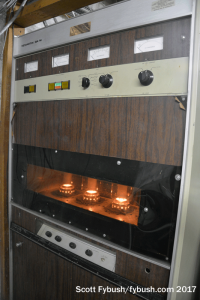
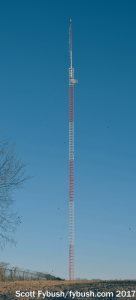
Omaha is, of course, right on a state line, and we start our excursions across the Missouri River on the Iowa side, up on the bluffs that give Council Bluffs its name.
What’s now Salem’s KOTK (1420) spent much of its existence as KOOO, the calls it had when it signed on in 1957 as a kilowatt daytimer. It spawned an FM sister in the 1970s (now Scripps’ KSRZ 104.5), and split for good from the FM in 2005 when Journal sold 1420 to Salem.
Out here in south Council Bluffs, you’d almost never know it’s 2017 or that you’re just a 10-minute drive from urban Omaha across the river. The old McMartin transmitter is still out here and still runs, woodgrain vinyl and all, though the Nautel to the right is usually powering things these days. The two-tower array still runs a kilowatt by day and drops down to 330 watts at night, and the phenomenal ground conductivity means 1420 does a nice job covering the metro even with relatively low power.
KOTK’s neighbor near the bridge in south Council Bluffs is the only AM licensed on the Iowa side, religious KLNG (1560 Council Bluffs), but we continue over the bridge into south Omaha.
Not far from the Henry Doorly Zoo (one of the best in the country) and the former site of Rosenblatt Stadium, until recently home to the College World Series (it’s now in a fancy new downtown ballpark), a little hill above the I-80/I-480 interchange is home to another venerable Omaha AM and a former sister to 1420, the station that’s now KOMJ (1490).
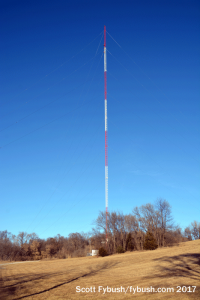
This was KYNN from its 1942 debut until the 1980s, when it began simulcasting FM sister KEZO-FM (92.3); more recently, it was doing sports and then swapped formats and calls with its then-Journal sister at 590 on the dial to become standards under the KOMJ calls. Journal sold off this AM, too, in 2007, and buyer Ted Tucker (Cochise Broadcasting) had just recently taken some FCC heat for lacking an Omaha main studio. Now in the hands of a company called Walnut Radio, LLC, 1490 is now “Boomer Radio” with a fun oldies format, and its tower on the hill here is also home to an FM translator, K281CJ (104.1).
You can’t do Omaha towers without heading up to North 72nd Street and vicinity, and that’s where we head next, starting with a visit to the oldest AM license in the state.
What’s now KCRO (660) started out in 1922 as the “Voice of the Omaha Grain Exchange,” WAAW, which must have caused no end of confusion when a rival station started up soon after as WOAW. (More on them in a moment.)
WAAW became KOWH when the Omaha World-Herald bought it in 1939, but it didn’t become world-famous for another decade and a half, when Todd Storz used the daytime-only signal as a test bed for what the world would soon know as “top-40 radio.” Legendary though it was, KOWH only lasted as a top-40 station for barely more than a decade; by the mid-60s it was sold to Starr Broadcasting, became KOZN, then went urban in the 1970s. By the early 1980s, 660 had gone religious under its current calls, KCRO (“Christian Radio Omaha,”) and now it’s part of the Salem family.
KCRO’s present transmitter site next to Orchard Park, off Hoffman Ave. just east of the big 72nd Street TV tower farm, dates only to 1968, which explains why such an old license has a relatively compact, utilitarian block building. There are several older transmitters here, but it’s that BE in the foreground that powers 660’s daytime kilowatt now (and 54 surprisingly big watts at night, too.)
There’s an FM tucked in here, too: BBN religious outlet KYFG (88.9) has its transmitter in the building and its antenna on the tower.,
So where was WAAW/KOWH for all those years before this site went up in 1968? Salem operations manager Mike Shane had been tempting us for a while now with his research into that very question, which revealed that the 1930s-era WAAW transmitter building was still standing – and just a mile away from the current site!
The Grain Exchange built a new transmitter site “outside Omaha city limits” in 1931, at a site north of town that would later have roads built around it and today sits at the corner of N. 60th and Girard Streets. The 1931-vintage building, as Mike discovered, still exists and is today divided into rental apartments – and we wonder if any remnants of the radio station still exist inside.
KOWH left this site in 1948 to move to a site very close to the existing KCRO tower, relocating to the tower at 60th and Hartman that had been built a few years earlier for what was originally KOAD-FM, KOWH’s first FM sister. (You’re guaranteed to need an Advil or three after trying to trace that FM history: KOAD-FM was at 94.3 and then 94.1, then went silent in 1948 after the AM moved here; KOWH put the FM back on the air in the 1960s using the KMEO calls that had also briefly been on 660, then was eventually sold off separately from the AM in the 1970s, pairing with 1490 as KYSS-FM. And then 94.1 became an FM sister to 590 as WOW-FM, remaining paired with 590 under Great Empire, Journal and Scripps even as those legacy WOW calls went away.)
There are still some mysteries yet to be solved here, in particular the exact location of the 60th and Hartman site that 660 used from 1948 until the current site went up in 1968. Was it claimed by the suburban development that now dominates the 60th Street corridor? Will we ever fully understand the incredibly tangled history of 94.1?
Be that as it may, it’s easier to understand the history of the other old-line AM that’s right up in the neighborhood. Not long after WAAW went on the air in 1922, it was followed by the Woodmen of the World’s WOAW, which soon reduced the confusion by changing calls to WOW in 1926.
In 1936, WOW moved from the downtown Woodmen building to a big piece of land at N. 56th Street and Kansas Avenue, and here it’s been ever since, blasting a big chunk of the Midwest with 5000 nondirectional watts day and night. It’s not WOW anymore, of course; under Journal it became KOMJ and then today’s KXSP, and one of these days we hope to get the chance to peek inside this venerable space.
What’s much easier to understand is the row of 1200-foot towers just to the west of the old-line AMs along N. 72nd Street. If the story of Omaha FM is complex, the story of Omaha TV is easy: in 1949, WOW-TV (Channel 6) and KMTV (Channel 3) both signed on from studio/transmitter facilities a few blocks apart on Farnam Street just west of downtown; in 1957, KETV (Channel 7) joined them nearby at 27th and Douglas; in the 1960s, all three stations moved their towers northwest to create this tower farm – and late on the night of July 4, 2003, KETV’s tower collapsed, with a replacement completed the next year.
Our tour starts at the north end of the tower farm, at the corner of 72nd and Crown Point Avenue, in the two-story building of what’s now WOWT. (Chronicle Broadcasting bought the former WOW-TV from Meredith in 1975 and had to change calls, which was the first step in the eventual disappearance of the historic three-letter callsign from town.)
All the transmitters are on the top floor here, with WOWT’s RF 22 digital rig in the main room and a neat row of FMs in the next room over.
(This was, I’d assume, where the original WOW-FM on 92.3, later KEZO, was located, and also where the later WOW-FM on 94.1 settled down for a time.)
From left to right, this lineup now includes KIWR (89.7 Council Bluffs, the radio voice of Iowa Western Community College), EMF’s “K-Love” KMLV (88.1 Ralston), Salem’s 106.5 translator for KCRO, K293CJ, and Salem’s “Fish” KGBI-FM (100.7), which moved here in 2010 after many years at another tower farm way out to the southwest. (We’ll see that site in an upcoming installment.)
The next stop south is the new KETV tower, and this was our first chance to see it in depth since it went up in 2004. This is a nice modern plant, with high ceilings and lots of power-handling and air-moving capacity, as one does these days. That empty space right inside the door to the transmitter room is, of course, where the analog channel 7 transmitter sat for just a few short years; it was on the air here for less than five years before the transition in 2009. The digital channel 20 transmitter is at the back of the room, across from a spacious rack area.
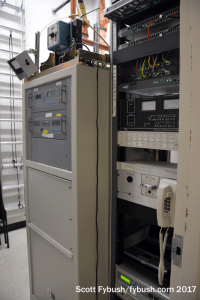
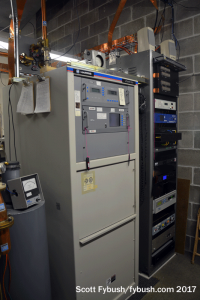
KETV never had its own radio sister, and its only FM tenant when the tower went down in 2003 was public radio KVNO (90.7), the University of Nebraska-Omaha’s station.
KVNO regrouped with a move one tower south to the KMTV (Channel 3) tower, where it’s still licensed, but when KETV rebuilt, KVNO put an aux facility on the new KETV tower.
The KETV tower had also just become home to NET public television’s KYNE (Channel 26) when we visited. KYNE’s old tower at the UNO campus was about to come down (don’t worry – we saw it and we’ll show it to you next week), and there’s a compact new shelter next to the KETV building that houses KYNE’s RF 17 transmitter.
We didn’t get in to KYNE, but we got to see both KVNO’s aux and main, and they’re similar Harris setups; over at the KMTV site, KVNO occupies a small back room tucked away in a corner behind the transmitter room for NRG’s KQKQ (98.5 Council Bluffs). KVNO and KQKQ feed a two-station combiner in the hallway that goes up to a shared antenna high on the KMTV tower, and we pause here for just a second to note the irony that this Scripps-owned tower carries none of Scripps’ own FM mains, for reasons we’ll explore in a moment.
KMTV’s original 1960s-era analog transmitter building didn’t have enough room for the DTV conversion, so channel 3 built on to the front of it, doubling its space to create a big new transmitter room where its channel 45 transmitter now sits (and where a new transmitter will go after the repack clears channel 45 in a few years and KMTV slides down to RF 31.)
The end of analog left the old part of KMTV’s building mostly empty, with some racks of legacy equipment and storage but nothing left of the analog 3 transmitter that was once a frequent E-skip visitor in the summertime here in Rochester. (The old channel 3 batwing still sits up top, though!) Peer through the old control room windows and you can just make out an aux (and former main, I think) for Scripps’ KSRZ (104.5).
(And remember that you can always click on any of these pictures, especially the tall-tower ones, for larger versions that better show the array of antennas way up there.)
We didn’t get in to the other buildings that surround the KETV or KMTV towers this time, but we’d seen them back in 2007. At KETV, iHeart’s KISO (96.1) and KXKT (103.7) share a combined antenna, and over at KMTV there’s iHeart’s KGOR (99.9) and a KXKT aux in an outbuilding.
And that leaves us with just one big tower at this farm that we haven’t examined in detail yet. Perhaps a future visit will get us inside the facility that Journal built (and successor Scripps now uses) at the south end of the tower farm; up here are KEZO (92.3), KQCH (94.1), KSRZ (104.5) and an aux for KKCD (105.9, with a main site at 27th and W in South Omaha.)
Thanks to Salem’s Mike Shane and KVNO’s Dave Kline for the tours!

As we announced a few weeks ago, the 2026 edition of the Tower Site Calendar will be the last.
We began publishing it 25 years ago, and the broadcast landscape is radically different now.
Radio World just ran an excellent article about us if you want to know more.
Once it’s gone, that’s it. We won’t be printing any more.
Thank you to everyone who saw our announcement and rushed to buy it. We appreciate you.
(There are some calendars from previous years if you want more of a tower photo fix — all under $5.)
But don’t wait to get this year’s Tower Site Calendar — buy it now!
We are selling the Broadcast Historian’s Calendar again this year, but we have that in an even smaller quantity — definitely don’t hesitate for that.
And visit the Fybush Media Store to check out our selection of books and videos, too!
And don’t miss a big batch of Omaha IDs next Wednesday, over at our sister site, TopHour.com!
Next week: Our Omaha Wrap-Up
In this week’s issue… NYC morning shows exit - Carton back amidst WFAN shakeup - FM signing off in Canada - More radio centennials
In this week’s issue… Veteran newsman returns - Remembering NY's Leitner, RI's Jones - CT AM saved - Maine AM moves - "Indie" adds suburban signals
In this week’s issue… Scripps stations face takeover - Sinclair moves more affiliations - CT stations sold - Maine AM surrendered - Remembering WVBR's Shapiro, WABC's Morgan
In this week’s issue… CT TV legend succumbs to cancer - Remembering PA's Adams - FCC still stalled by shutdown - Pittsburgh morning host exits